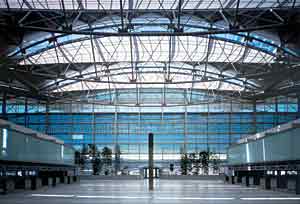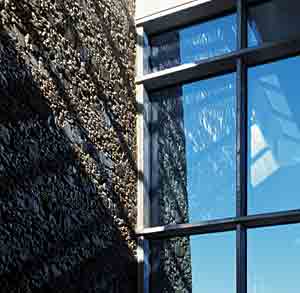Exploring the High-Performance Benefits of Laminated Glass
Glass specimens were subject to racking in the plane of the wall and to racking that moved the bottom supports both along their axis in the plane of the wall, as well as out of the plane of the wall but parallel to the top supports. The latter action simulates interstory drifts between floors in both horizontal directions. The impressive performance of laminated glass shows that laminated glazing can be specified to protect occupants and pedestrians from falling glass during a severe earthquake and continue to protect the building envelope.
|
Security and Blast Resistance
The dangers associated with flying glass during an explosion became tragically evident in the aftermath of the 1995 Alfred P. Murrah bombing in Oklahoma City. More than 200 people were injured by shards of glass in a two-mile radius of the bombing. A staggering 80 percent of the windows within two blocks were affected; within one-and-a-half blocks, 100 percent. The General Services Administration's (GSA) new Oklahoma City Federal Campus, designed by Ross Barney + Jankowski, employs laminated glass to create a bright, daylit building that reflects the GSA's goal of transparent security, providing a high level of protection invisible to the public eye.
It is, however, important to note that while laminated glass is a critical element when designing blast-resistant structures, the glass must be set in an adequately designed frame in order to be effective.
While laminated glass was initially used by GSA to respond to the threat of terrorism against the new Oklahoma City Federal Campus, it has since become a design standard for federal buildings across the country. GSA requires that all federal courthouses and other high-security buildings be built with blast-resistant glazing, and laminated glass is one of the only glass solutions strong enough to meet these requirements. Just as in the Oklahoma City campus, laminated glass is also being used in other public- and private-sector buildings to create secure environments that appear open and accessible to the public, thereby balancing security and openness.
Multiple Benefits for many Applications
It is important to remember that laminated glass must be used in an appropriate configuration to provide the desired level of protection and performance. Available in a variety of glass and laminate thicknesses and in a number of insulating and non-insulating configurations, laminated glass is suitable for many applications. In addition to selecting the appropriate glass configuration, it is important to select a suitable framing system. For hurricane or blast protection conditions, the framing system must be strong enough to support the glazing.
|
Today, laminated glass is proving to be a significant design element in meeting twenty-first century architectural challenges. A versatile material, it provides building projects with multiple benefits, from safety and security protection and resistance to natural disasters, to sound transmission, sustainability, and many design options. The ability to coordinate with an insulating unit and high performance coatings gives laminated glass even greater performance qualities. With a nearly infinite selection of colors, textures, and laminate combinations available, laminated glass offers architects many opportunities to create outstanding buildings and achieve design excellence.










